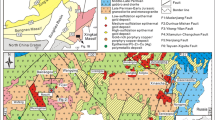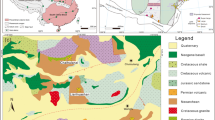Abstract
The coesite-bearing eclogites and associated ultramafic rocks of Bixiling form the largest metamorphic complex in the Dabie–Sulu ultrahigh-pressure (UHP) metamorphic belt. They mainly consist of “fresh” eclogite, kyanite-rich eclogite, retrograded eclogite and garnet peridotite. Fluid inclusion and oxygen isotope studies have been carried out on the different types of eclogite and peridotite in order to identify the role of fluids during the metamorphic evolution culminating in UHP metamorphism. Five types of fluid inclusions were distinguished based on textural criteria and fluid compositions: (1) primary Ca-rich brines in quartz blebs in kyanite; (2) primary NaCl-dominated high-salinity inclusions in omphacite and kyanite; (3) primary NaCl-dominated medium- to high-salinity inclusions in matrix quartz; (4) carbonic inclusions in omphacite and matrix quartz; (5) secondary low-salinity aqueous (or pure water) inclusions in matrix quartz. The Ca-rich fluid inclusions in quartz blebs in kyanite represent the earliest recognizable fluids (prograde metamorphism) as they largely escaped late re-equilibration. Fluid inclusions in omphacite and kyanite may have been trapped during peak metamorphic conditions, whereas low-salinity aqueous inclusions in matrix quartz were trapped during the latest stage of uplift. UV-laser oxygen isotope measurements show that garnet and clinopyroxene from the “fresh” eclogite, kyanite-rich eclogite and garnet peridotite have narrow δ18O values ranging from 3.0 to 3.9‰. In contrast, garnet and omphacite in retrograded eclogite have δ18O values of −1.8 to −1.2 and of −1.1 to −0.6‰, respectively. The difference in oxygen isotope composition is interpreted to result from partial oxygen isotope exchange between the UHP complex and retrograde fluids during late exhumation. Fluids derived from the surrounding gneiss were probably responsible for the low-salinity solutions found in secondary fluid inclusions and the lowering of the δ18O values of the retrograded eclogite.
Similar content being viewed by others
Author information
Authors and Affiliations
Additional information
Received: 5 October 1999 / Accepted: 15 December 1999
Rights and permissions
About this article
Cite this article
Xiao, Y., Hoefs, J., van den Kerkhof, A. et al. Fluid history of UHP metamorphism in Dabie Shan, China: a fluid inclusion and oxygen isotope study on the coesite-bearing eclogite from Bixiling. Contrib Mineral Petrol 139, 1–16 (2000). https://doi.org/10.1007/s004100050570
Issue Date:
DOI: https://doi.org/10.1007/s004100050570




